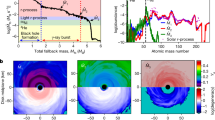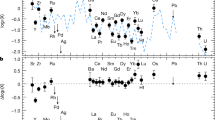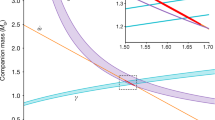Abstract
The cosmic origin of elements heavier than iron has long been uncertain. Theoretical modelling1,2,3,4,5,6,7 shows that the matter that is expelled in the violent merger of two neutron stars can assemble into heavy elements such as gold and platinum in a process known as rapid neutron capture (r-process) nucleosynthesis. The radioactive decay of isotopes of the heavy elements is predicted8,9,10,11,12 to power a distinctive thermal glow (a ‘kilonova’). The discovery of an electromagnetic counterpart to the gravitational-wave source13 GW170817 represents the first opportunity to detect and scrutinize a sample of freshly synthesized r-process elements14,15,16,17,18. Here we report models that predict the electromagnetic emission of kilonovae in detail and enable the mass, velocity and composition of ejecta to be derived from observations. We compare the models to the optical and infrared radiation associated with the GW170817 event to argue that the observed source is a kilonova. We infer the presence of two distinct components of ejecta, one composed primarily of light (atomic mass number less than 140) and one of heavy (atomic mass number greater than 140) r-process elements. The ejected mass and a merger rate inferred from GW170817 imply that such mergers are a dominant mode of r-process production in the Universe.
This is a preview of subscription content, access via your institution
Access options
Access Nature and 54 other Nature Portfolio journals
Get Nature+, our best-value online-access subscription
$29.99 / 30 days
cancel any time
Subscribe to this journal
Receive 51 print issues and online access
$199.00 per year
only $3.90 per issue
Buy this article
- Purchase on Springer Link
- Instant access to full article PDF
Prices may be subject to local taxes which are calculated during checkout





Similar content being viewed by others
References
Lattimer, J. M. & Schramm, D. N. Black-hole-neutron-star collisions. Astrophys. J. 192, L145–L147 (1974)
Eichler, D., Livio, M., Piran, T. & Schramm, D. N. Nucleosynthesis, neutrino bursts and gamma-rays from coalescing neutron stars. Nature 340, 126–128 (1989)
Freiburghaus, C., Rosswog, S. & Thielemann, F. R-process in neutron star mergers. Astrophys. J. 525, L121–L124 (1999)
Rosswog, S. et al. Mass ejection in neutron star mergers. Astron. Astrophys. 341, 499–526 (1999)
Perego, A. et al. Neutrino-driven winds from neutron star merger remnants. Mon. Not. R. Astron. Soc. 443, 3134–3156 (2014)
Just, O., Bauswein, A., Pulpillo, R. A., Goriely, S. & Janka, H.-T. Comprehensive nucleosynthesis analysis for ejecta of compact binary mergers. Mon. Not. R. Astron. Soc. 448, 541–567 (2015)
Sekiguchi, Y., Kiuchi, K., Kyutoku, K., Shibata, M. & Taniguchi, K. Dynamical mass ejection from the merger of asymmetric binary neutron stars: radiation-hydrodynamics study in general relativity. Phys. Rev. D 93, 124046 (2016)
Li, L. & Paczynski, B. Transient events from neutron star mergers. Astrophys. J. 507, L59–L62 (1998)
Metzger, B. D. et al. Electromagnetic counterparts of compact object mergers powered by the radioactive decay of r-process nuclei. Mon. Not. R. Astron. Soc. 406, 2650–2662 (2010)
Roberts, L. F., Kasen, D., Lee, W. H. & Ramirez-Ruiz, E. Electromagnetic transients powered by nuclear decay in the tidal tails of coalescing compact binaries. Astrophys. J. 736, L21 (2011)
Barnes, J. & Kasen, D. Effect of a high opacity on the light curves of radioactively powered transients from compact object mergers. Astrophys. J. 775, 18 (2013)
Kasen, D., Badnell, N. R. & Barnes, J. Opacities and spectra of the r-process ejecta from neutron star mergers. Astrophys. J. 775, 25 (2013)
LIGO Scientific Collaboration and Virgo Collaboration. GW170817: observation of gravitational waves from a binary neutron star inspiral. Phys. Rev. Lett. 119, 161101 (2017)
Arcavi, I. et al. Optical emission from a kilonova following a gravitational-wave-detected neutron-star merger. Nature http://doi.org/10.1038/nature24291 (2017)
Kilpatrick, C. D. et al. Electromagnetic evidence that SSS17a is the result of a binary neutron star merger. Science http://doi.org/10.1126/science.aaq0073 (2017)
Cowperthwaite, P. S. et al. The electromagnetic counterpart of the binary neutron star merger LIGO/Virgo GW170817. II. UV, optical, and near-infrared light curves and comparison to kilonova models. Astrophys. J. 848, https://doi.org/10.3847/2041-8213/aa8fc7 (2017)
Kasliwal, M. et al. Illuminating gravitational waves: a concordant picture of photons from a neutron star merger. Science http://doi.org/10.1126/science.aap9455 (2017)
Coulter, D. A. et al. LIGO/Virgo G298048: potential optical counterpart discovered by Swope telescope. GCN Circ. 21529 (2017)
Drout, M. R. et al. Light curves of the neutron star merger GW170817/SSS17a: implications for r-process nucleosynthesis. Science http://doi.org/10.1126/science.aaq0049 (2017)
Shappee, B. J. et al. Early spectra of the gravitational wave source GW170817: evolution of a neutron star merger. Science http://doi.org/10.1126/science.aaq0186 (2017)
Nicholl, M. et al. The electromagnetic counterpart of the binary neutron star merger LIGO/Virgo GW170817. III. Optical and UV spectra of a blue kilonova from fast polar ejecta. Astrophys. J. 848, https://doi.org/10.3847/2041-8213/aa9029 (2017)
Oechslin, R., Janka, H.-T. & Marek, A. Relativistic neutron star merger simulations with non- zero temperature equations of state. I. Variation of binary parameters and equation of state. Astron. Astrophys. 467, 395–409 (2007)
Metzger, B. D., Thompson, T. A. & Quataert, E. On the conditions for neutron-rich gamma- ray burst outflows. Astrophys. J. 676, 1130–1150 (2008)
Dessart, L., Ott, C. D., Burrows, A., Rosswog, S. & Livne, E. Neutrino signatures and the neutrino-driven wind in binary neutron star mergers. Astrophys. J. 690, 1681–1705 (2009)
Lee, W. H., Ramirez-Ruiz, E. & Lopez-Camara, D. Phase transitions and He-synthesis-driven winds in neutrino cooled accretion disks: prospects for late flares in short gamma-ray bursts. Astrophys. J. 699, L93–L96 (2009)
Fernandez, R. & Metzger, B. D. Delayed outflows from black hole accretion tori following neutron star binary coalescence. Mon. Not. R. Astron. Soc. 435, 502–517 (2013)
Metzger, B. D. & Fernandez, R. Red or blue? A potential kilonova imprint of the delay until black hole formation following a neutron star merger. Mon. Not. R. Astron. Soc. 441, 3444–3453 (2014)
Wanajo, S. et al. Production of all the r-process nuclides in the dynamical ejecta of neutron star mergers. Astrophys. J. 789, L39 (2014)
Tanaka, M. & Hotokezaka, K. Radiative transfer simulations of neutron star merger ejecta. Astrophys. J. 775, 113 (2013)
Cowperthwaite, P. S. & Berger, E. A comprehensive study of detectability and contamination in deep rapid optical searches for gravitational wave counterparts. Astrophys. J. 814, 25 (2015)
Chornock, R. et al. The electromagnetic counterpart of the binary neutron star merger LIGO/Virgo GW170817. IV. Detection of near-infrared signatures of r-process nucleosynthesis with Gemini-South. Astrophys. J. 848, https://doi.org/10.3847/2041-8213/aa905c (2017)
Hotokezaka, K. et al. Mass ejection from the merger of binary neutron stars. Phys. Rev. D 87, 024001 (2013)
Kasen, D., Fernandez, R. & Metzger, B. D. Kilonova light curves from the disc wind outflows of compact object mergers. Mon. Not. R. Astron. Soc. 450, 1777–1786 (2015)
Tanaka, M. et al. Radioactively powered emission from black hole-neutron star mergers. Astrophys. J. 780, 31 (2014)
Fernandez, R. et al. Dynamics, nucleosynthesis, and kilonova signature of black hole-neutron star merger ejecta. Class. Quantum Gravity 34, 154001 (2017)
Wollaeger, R. T. et al. Impact of ejecta morphology and composition on the electromagnetic signatures of neutron star mergers. Preprint at https://arxiv.org/abs/1705.07084 (2017)
Chevalier, R. A. & Soker, N. Asymmetric envelope expansion of supernova1987A. Astrophys. J. 341, 867–882 (1989)
Kasen, D., Thomas, R. C. & Nugent, P. Time-dependent Monte Carlo radiative transfer calculations for three-dimensional supernova spectra, light curves, and polarization. Astrophys. J. 651, 366–380 (2006)
Roth, N. & Kasen, D. Monte Carlo radiation-hydrodynamics with implicit methods. Astrophys. J. Suppl. Ser. 217, 9 (2015)
Lippuner, J. & Roberts, L. F. r-Process lanthanide production and heating rates in kilonovae. Astrophys. J. 815, 82 (2015)
Barnes, J., Kasen, D., Wu, M.-R. & Martinez-Pinedo, G. Radioactivity and thermalization in the ejecta of compact object mergers and their impact on kilonova light curves. Astrophys. J. 821, 110 (2016)
Pinto, P. A. & Eastman, R. G. The physics of type Ia supernova light curves. II. Opacity and diffusion. Astrophys. J. 530, 757–776 (2000)
Tanaka, M. et al. Properties of kilonovae from dynamical and post-merger ejecta of neutron star mergers. Preprint at https://arxiv.org/abs/1708.09101 (2017)
Badnell, N. R. A Breit-Pauli distorted wave implementation for AUTOSTRUCTURE. Comput. Phys. Commun. 182, 1528–1535 (2011)
Karp, A. H., Lasher, G., Chan, K. L. & Salpeter, E. E. The opacity of expanding media: the effect of spectral lines. Astrophys. J. 214, 161–178 (1977)
Eastman, R. G. & Pinto, P. A. Spectrum formation in supernovae: numerical techniques. Astrophys. J. 412, 731–751 (1993)
Fontes, C. J. et al. A line-smeared treatment of opacities for the spectra and light curves from macronovae. Preprint at https://arxiv.org/abs/1702.02990 (2017)
Symbalisty, E. & Schramm, D. N. Neutron star collisions and the r-process. Astrophys. Lett. 22, 143–145 (1982)
Goriely, S., Bauswein, A. & Janka, H.-T. r-Process nucleosynthesis in dynamically ejected matter of neutron star mergers. Astrophys. J. 738, L32 (2011)
Burbidge, E. M., Burbidge, G. R., Fowler, W. A. & Hoyle, F. Synthesis of the elements in stars. Rev. Mod. Phys. 29, 547–650 (1957)
Cameron, A. G. W. Nuclear reactions in stars and nucleogenesis. Publ. Astron. Soc. Pac. 69, 201 (1957)
Tanvir, N. R. et al. A ‘kilonova’ associated with the short-duration γ-ray burst GRB 130603B. Nature 500, 547–549 (2013)
Berger, E., Fong, W. & Chornock, R. An r-process kilonova associated with the short-hard GRB 130603B. Astrophys. J. 774, L23 (2013)
Wallner, A. et al. Abundance of live 244Pu in deep-sea reservoirs on Earth points to rarity of actinide nucleosynthesis. Nat. Commun. 6, 5956 (2015)
Hotokezaka, K., Piran, T. & Paul, M. Short-lived 244Pu points to compact binary mergers as sites for heavy r-process nucleosynthesis. Nat. Phys. 11, 1042 (2015)
Ji, A. P., Frebel, A., Chiti, A. & Simon, J. D. r-Process enrichment from a single event in an ancient dwarf galaxy. Nature 531, 610–613 (2016)
Macias, P. & Ramirez-Ruiz, E. A stringent limit on the mass production rate of r-process elements in the Milky Way. Preprint at https://arxiv.org/abs/1609.04826 (2016)
Abbott, B. P. et al. Upper limits on the rates of binary neutron star and neutron star-black hole mergers from Advanced LIGO’s first observing run. Astrophys. J. 832, L21 (2016)
Abadie, J. et al. Predictions for the rates of compact binary coalescences observable by ground-based gravitational-wave detectors. Class. Quantum Gravity 27, 173001 (2010)
Kalogera, V. et al. Erratum: “The cosmic coalescence rates for double neutron star binaries” (ApJ, 601, L179 [2004]). Astrophys. J. 614, L137–L138 (2004)
Kim, C., Perera, B. B. P. & McLaughlin, M. A. Implications of PSR J0737−3039B for the Galactic NS–NS binary merger rate. Mon. Not. R. Astron. Soc. 448, 928–938 (2015)
Qian, Y.-Z. Supernovae versus neutron star mergers as the major r-process sources. Astrophys. J. 534, L67–L70 (2000)
Cowan, J. J. & Thielemann, F.-K. r-Process nucleosynthesis in supernovae. Phys. Today 57, 47–53 (2004)
Sneden, C., Cowan, J. J. & Gallino, R. Neutron-capture elements in the early galaxy. Annu. Rev. Astron. Astrophys. 46, 241–288 (2008)
Bauswein, A., Ardevol Pulpillo, R., Janka, H. T. & Goriely, S. Nucleosynthesis constraints on the neutron star-black hole merger rate. Astrophys. J. 795, L9 (2014)
Shen, S. et al. The history of r-process enrichment in the Milky Way. Astrophys. J. 807, 115 (2015)
van de Voort, F., Quataert, E., Hopkins, P. F., Keres, D. & Faucher-Giguere, C.-A. Galactic r-process enrichment by neutron star mergers in cosmological simulations of a Milky Way-mass galaxy. Mon. Not. R. Astron. Soc. 447, 140–148 (2015)
Perley, D. A. et al. GRB 080503: implications of a naked short gamma-ray burst dominated by extended emission. Astrophys. J. 696, 1871–1885 (2009)
Acknowledgements
D.K. is supported in part by a Department of Energy (DOE) Office early career award DE-SC0008067, a DOE Office of Nuclear Physics award DE-SC0017616, and by the Director, Office of Energy Research, Office of High Energy and Nuclear Physics, Divisions of Nuclear Physics, of the US DOE under contract number DE-AC02-05CH11231. This work was supported in part by the DOE SciDAC award DE-SC0018297. E.R.-R. acknowledges support from a Niels Bohr Professorship funded by DNRF, and support from UCMEXUS, the David and Lucile Packard Foundation. This research is funded in part by the Gordon and Betty Moore Foundation through grant GBMF5076. E.Q. was funded in part by the Simons Foundation through a Simons Investigator Award. J.B. is supported by the National Aeronautics and Space Administration (NASA) through the Einstein Fellowship Program, grant number PF7-180162, issued by the Chandra X-ray Observatory Center, which is operated by the Smithsonian Astrophysical Observatory for and on behalf of the National Aeronautics Space Administration under contract NAS8-03060. This research used resources of the National Energy Research Scientific Computing Center, a DOE Office of Science User Facility supported by the Office of Science of the US DOE under contract number DE AC02-05CH11231. J.B. is an Einstein Fellow.
Author information
Authors and Affiliations
Contributions
D.K. carried out the model calculations and analysis and led the writing of the manuscript. B.M. helped with the text, aided in the theoretical interpretation, and contributed to the schematic figure of mass ejection. J.B. carried out multi-dimensional radiation transport calculations to estimate the effects of asymmetry on the light curves. E.Q. provided theoretical interpretations and aided in the writing of the manuscript. E.R.-R. provided theoretical input and estimates of the contribution of mergers to the r-process in the Galaxy.
Corresponding author
Ethics declarations
Competing interests
The authors declare no competing financial interests.
Additional information
Reviewer Information Nature thanks R. Chevalier and C. Miller for their contribution to the peer review of this work.
Publisher's note: Springer Nature remains neutral with regard to jurisdictional claims in published maps and institutional affiliations.
Extended data figures and tables
Extended Data Figure 1 Dependence of model light curves on the ejecta density profile and compositional stratification.
The models all have mass M = 0.025M⊙ and velocity vk = 0.25c. a, Comparison of models with a homogenous composition to one where the lanthanide mass fraction varies from Xlan = 10−6 at the outer ejecta edge to Xlan = 10−4 in the interior (see equation (7)). b, Comparison of models with different density gradient in the outer layers. A shallower exponent (n < 10) leads to a cooler photosphere and suppresses the early ultraviolet and blue emission. The light curves at times t ≥ 1 d and in redder bands are essentially independent of the outer density profile.
Extended Data Figure 2 Multi-dimensional models demonstrating the orientation dependence of asymmetric kilonova light curves.
a, Bolometric light curves of light r-process ejecta (with M = 0.025M⊙, vk = 0.15c and Xlan = 10−5) distributed in a conical polar region of opening half angle 45°. b, Bolometric light curves of an oblate ellipsoidal distribution of heavy r-process ejecta (with M = 0.04M⊙, vk = 0.1c and Xlan = 10−2) with an axis ratio of a = 4. The orientation effects lead to modest variations in the peak brightness. However, these models do not account for both a polar and an ellipsoidal component being present and influencing each other.
Rights and permissions
About this article
Cite this article
Kasen, D., Metzger, B., Barnes, J. et al. Origin of the heavy elements in binary neutron-star mergers from a gravitational-wave event. Nature 551, 80–84 (2017). https://doi.org/10.1038/nature24453
Received:
Accepted:
Published:
Issue Date:
DOI: https://doi.org/10.1038/nature24453
This article is cited by
-
A large-scale magnetic field produced by a solar-like dynamo in binary neutron star mergers
Nature Astronomy (2024)
-
The discovery space of ELT-ANDES. Stars and stellar populations
Experimental Astronomy (2024)
-
Origin of the elements
The Astronomy and Astrophysics Review (2023)
Comments
By submitting a comment you agree to abide by our Terms and Community Guidelines. If you find something abusive or that does not comply with our terms or guidelines please flag it as inappropriate.



